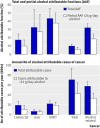Alcohol attributable burden of incidence of cancer in eight European countries based on results from prospective cohort study
- PMID: 21474525
- PMCID: PMC3072472
- DOI: 10.1136/bmj.d1584
Alcohol attributable burden of incidence of cancer in eight European countries based on results from prospective cohort study
Abstract
Objective: To compute the burden of cancer attributable to current and former alcohol consumption in eight European countries based on direct relative risk estimates from a cohort study.
Design: Combination of prospective cohort study with representative population based data on alcohol exposure. Setting Eight countries (France, Italy, Spain, United Kingdom, the Netherlands, Greece, Germany, Denmark) participating in the European Prospective Investigation into Cancer and Nutrition (EPIC) study.
Participants: 109,118 men and 254,870 women, mainly aged 37-70.
Main outcome measures: Hazard rate ratios expressing the relative risk of cancer incidence for former and current alcohol consumption among EPIC participants. Hazard rate ratios combined with representative information on alcohol consumption to calculate alcohol attributable fractions of causally related cancers by country and sex. Partial alcohol attributable fractions for consumption higher than the recommended upper limit (two drinks a day for men with about 24 g alcohol, one for women with about 12 g alcohol) and the estimated total annual number of cases of alcohol attributable cancer.
Results: If we assume causality, among men and women, 10% (95% confidence interval 7 to 13%) and 3% (1 to 5%) of the incidence of total cancer was attributable to former and current alcohol consumption in the selected European countries. For selected cancers the figures were 44% (31 to 56%) and 25% (5 to 46%) for upper aerodigestive tract, 33% (11 to 54%) and 18% (-3 to 38%) for liver, 17% (10 to 25%) and 4% (-1 to 10%) for colorectal cancer for men and women, respectively, and 5.0% (2 to 8%) for female breast cancer. A substantial part of the alcohol attributable fraction in 2008 was associated with alcohol consumption higher than the recommended upper limit: 33,037 of 178,578 alcohol related cancer cases in men and 17,470 of 397,043 alcohol related cases in women.
Conclusions: In western Europe, an important proportion of cases of cancer can be attributable to alcohol consumption, especially consumption higher than the recommended upper limits. These data support current political efforts to reduce or to abstain from alcohol consumption to reduce the incidence of cancer.
Conflict of interest statement
Competing interests: All authors have completed the Unified Competing Interest form at
Figures



References
-
- Rehm J, Mathers C, Popova S, Thavorncharoensap M, Teerawattananon Y, Patra J. Global burden of disease and injury and economic cost attributable to alcohol use and alcohol-use disorders. Lancet 2009;373:2223-33. - PubMed
-
- Baan R, Straif K, Grosse Y, Secretan B, El Ghissassi F, Bouvard V, et al. Carcinogenicity of alcoholic beverages. Lancet Oncol 2007;8:292-3. - PubMed
-
- Secretan B, Straif K, Baan R, Grosse Y, El Ghissassi F, Bouvard V, et al. A review of human carcinogens—part E: tobacco, areca nut, alcohol, coal smoke, and salted fish. Lancet Oncol 2009;10:1033-4. - PubMed
-
- Hashibe M, Brennan P, Chuang SC, Boccia S, Castellsague X, Chen C, et al. Interaction between tobacco and alcohol use and the risk of head and neck cancer: pooled analysis in the International Head and Neck Cancer Epidemiology Consortium. Cancer Epidemiol Biomarkers Prev 2009;18:541-50. - PMC - PubMed
-
- Allen NE, Beral V, Casabonne D, Kan SW, Reeves GK, Brown A, et al. Moderate alcohol intake and cancer incidence in women. J Natl Cancer Inst 2009;101:296-305. - PubMed
